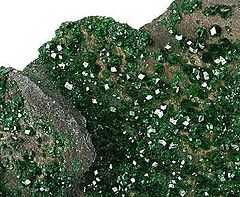Uvarovite
From Wikipedia, the free encyclopedia
| Uvarovite | |
|---|---|
 Uvarovite druse from Urals Region, Russia (size: 18.3 x 13.1 x 2.0 cm) | |
| General | |
| Category | Nesosilicate |
| Formula (repeating unit) | Ca3Cr2Si3O12 |
| Strunz classification | 09.AD.25 |
| Crystal symmetry |
Isometric hexoctahedral H-M symbol (4/m32/m) Space group: I a3d |
| Unit cell | a = 11.99 Å; Z=8 |
| Identification | |
| Color | Green, emerald-green, green-black |
| Crystal habit | Euhedral crystals, granular, massive |
| Crystal system | Cubic |
| Fracture | Uneven, conchoidal |
| Mohs scale hardness | 6.5-7.5 |
| Luster | Vitreous |
| Streak | White |
| Diaphaneity | Transparent, translucent |
| Specific gravity | 3.77 - 3.81 |
| Optical properties | Isotropic |
| Refractive index | n = 1.865 |
| Other characteristics | Fluorescent red in both short and long UV |
| References | [1][2][3] |
Uvarovite is a chromium-bearing garnet group species with the formula: Ca3Cr2(SiO4)3. It was discovered in 1832 by Germain Henri Hess who named it after Count Sergei Semenovitch Uvarov (1765–1855), a Russian statesman and amateur mineral collector.[1]
Uvarovite is one of the rarest of the garnet group minerals, and is the only consistently green garnet species, with an emerald-green color. It occurs as well-formed fine-sized crystals.
It is found associated with chromium ores in Spain, Russia, and Quebec in Canada. It also occurs in Finland, Norway, and South Africa.

Pendant in uvarovite, a rare bright-green garnet. The long dimension is 2 cm (0.8 inch)
See also
References
External links
| Wikimedia Commons has media related to Uvarovite. |
This article is issued from Wikipedia. The text is available under the Creative Commons Attribution/Share Alike; additional terms may apply for the media files.